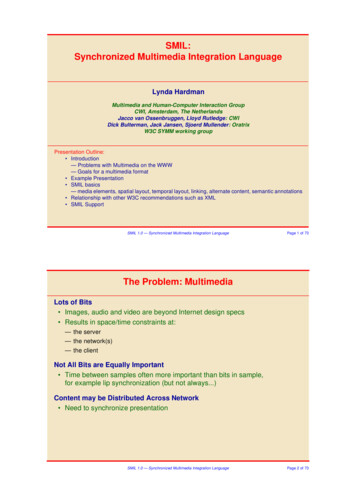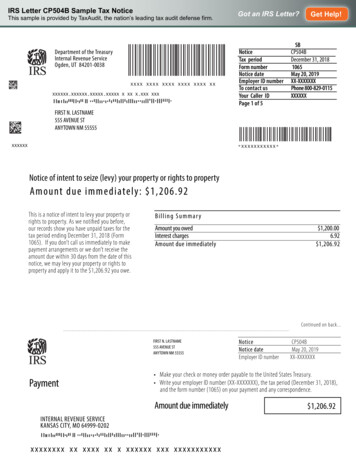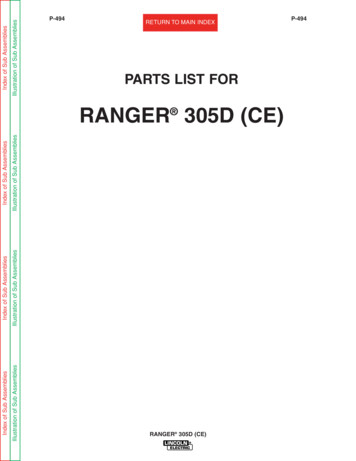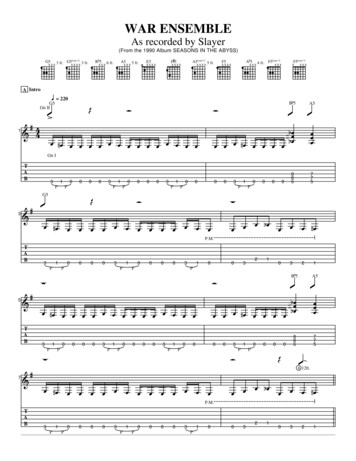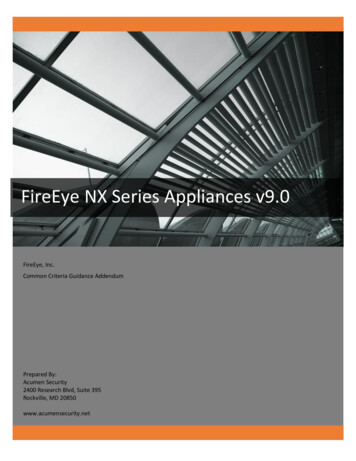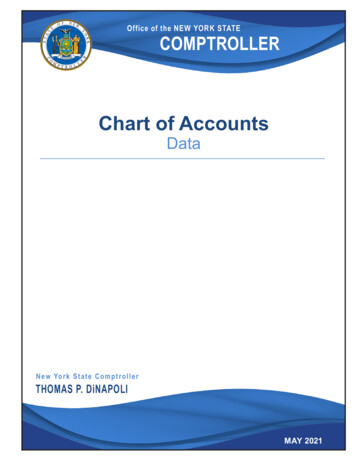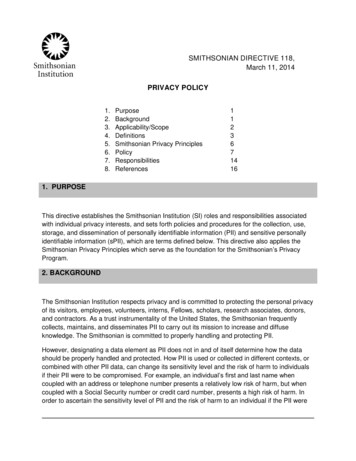
Transcription
SMITHSONIAN DIRECTIVE 118,March 11, 2014xxxxx xx, xxxxPRIVACY ty/ScopeDefinitionsSmithsonian Privacy 161. PURPOSEThis directive establishes the Smithsonian Institution (SI) roles and responsibilities associatedwith individual privacy interests, and sets forth policies and procedures for the collection, use,storage, and dissemination of personally identifiable information (PII) and sensitive personallyidentifiable information (sPII), which are terms defined below. This directive also applies theSmithsonian Privacy Principles which serve as the foundation for the Smithsonian’s PrivacyProgram.2. BACKGROUNDThe Smithsonian Institution respects privacy and is committed to protecting the personal privacyof its visitors, employees, volunteers, interns, Fellows, scholars, research associates, donors,and contractors. As a trust instrumentality of the United States, the Smithsonian frequentlycollects, maintains, and disseminates PII to carry out its mission to increase and diffuseknowledge. The Smithsonian is committed to properly handling and protecting PII.However, designating a data element as PII does not in and of itself determine how the datashould be properly handled and protected. How PII is used or collected in different contexts, orcombined with other PII data, can change its sensitivity level and the risk of harm to individualsif their PII were to be compromised. For example, an individual’s first and last name whencoupled with an address or telephone number presents a relatively low risk of harm, but whencoupled with a Social Security number or credit card number, presents a high risk of harm. Inorder to ascertain the sensitivity level of PII and the risk of harm to an individual if the PII were
SD 118 — 3/11/142. BACKGROUND (continued)to be compromised, the Smithsonian must evaluate the totality of the circumstancessurrounding its use of the PII, such as the context, purpose, aggregation with other PII elementsor other information, and the location in which it will be used, collected, stored, or disseminated.Although the Smithsonian Institution is not subject to many of the laws that govern informationprivacy for Executive Branch agencies,1 it applies information privacy best practices to supportits activities as a 501(c)(3) organization whose mission is “to increase and diffuse knowledge”and adopts Generally Accepted Privacy Principles (GAPP) as the foundation for its privacypolicies and procedures.This SD 118, Privacy Policy, replaces the previous SD 118, Privacy Breach Notification Policy.The Privacy Breach Notification Policy is now renumbered to SD 119.3. APPLICABILITY/SCOPEThis directive applies to all Smithsonian Staff and Affiliated Persons, as they are defined below.This directive does not apply to collection objects, archival materials, their digital surrogates, ortheir supporting documentation that contain PII or sPII. Those materials shall be collected, used,and protected in accordance with SD 600, Collections Management, and each Unit’s specificcollection and archival policies.2This directive addresses personal privacy interests only, and does not address other attributesof data that may warrant a higher level of care in its handling or disclosure. Several otherSmithsonian Directives designate certain types of Smithsonian information or data as sensitive1Such laws include the Privacy Act, the E-Government Act of 2002 (Pub. L. No. 107–347), the FederalInformation Security Management Act (FISMA), and numerous Office of Management and Budget (OMB)Memorandums (M-05-08, M-07-16, M-06-19, M-06-15, M-08-21, and M-99-18).2Refer to SD 600, Collections Management; SD 501, Archives and Records of the SmithsonianInstitution; SD 503, Management of Archives and Special Collections in the Smithsonian Institution; andSD 609, Digital Asset Access and Use. PII and sPII, in this context, may only be used, disclosed, or madepublically available to diffuse knowledge, where the collecting or archival unit has obtained appropriatepermission or consent from the appropriate owner or lender.2
SD 118 — 3/11/143. APPLICABILITY/SCOPE (continued)or confidential.3 As discussed in those directives, or as may be required by applicable law,information or data that falls within this designation may require a higher level of care in itshandling and treatment.4Any violation of this policy may be subject to disciplinary action or other appropriate actions.4. DEFINITIONSAffiliated Persons. For purposes of this directive, the term Affiliated Persons is defined as thefollowing: (i) contractors who perform work similar to Smithsonian employees, such asemployees of temporary help firms; (ii) volunteers, as defined in SD 208, Ethical Standards forSI Volunteers; (iii) interns and Fellows; (iv) emeriti, as defined in SD 206, EmeritusDesignations; (v) visiting researchers, including scientists, scholars, and students; (vi) researchassociates, as defined in SD 205, Research Associates; and (vii) Regents and Advisory Boardmembers.Children’s Online Privacy Protection Act (COPPA). COPPA refers to a statute administeredby the Federal Trade Commission Act regarding the protection of children’s personalinformation when they engage in online activities. For purposes of COPPA, children are definedas individuals under 13 years old. In accordance with SD 950, Management of the SmithsonianWeb, the Smithsonian, although not subject to COPPA, follows it as a best practice.Generally Accepted Privacy Principles (GAPP). GAPP refers to 10 generally acceptedprivacy principles developed by privacy professionals in North America as a framework foreffective organizational privacy programs.Personally Identifiable Information (PII). Personally identifiable information (PII) refers toinformation about individuals which may or may not be publically available, that can be used to3Examples of sensitive data include protected species and cultural/Native American Repatriation data(SDs 600, 603, and 503); human subject research data (SD 606); SI employee/personnel data (e.g., inSDs 212, 213, 214, and 222); investigative information (e.g., SDs 224 by the Office of Protection Services[OPS] and107 by the Office of Inspector General [OIG]); contract data prior to award, contractor/vendorlabor rates/pricing (e.g., SDs 314 by the Office of Contracting and Personal Property Management[OCon&PPM]); and donor information (e.g., SD 809).4Refer to SD 920, Life Cycle Management, which enumerates a list of sensitive data elements, and SD807, Requests for Smithsonian Institution Information, which restricts the disclosure of certain types ofSmithsonian information consistent with exemptions set forth in the Freedom of Information Act.3
SD 118 — 3/11/144. DEFINITIONS (continued)distinguish or indicate an individual’s identity, and any other information that is linked or linkableto an individual, such as medical, educational, financial or employment information. Examples ofPII include, but are not limited to: General Personal Data: full name, maiden name, alias, full date of birth; Address information: street address or email address; Personal Identification Number: Social Security number, passport number, driver’slicense number, taxpayer identification number, financial account number, credit cardnumber; Security Information: password, mother’s maiden name; and Personal Characteristics: photographs and voice files that identify individuals,fingerprints, handwriting, biometric data such as retina scans, voice signatures, andfacial geometry.Privacy Breach. A privacy breach is defined in SD 119, Privacy Breach Notification Policy (atthe time of this writing), as the unauthorized acquisition, access, use, or disclosure of PII or sPIIthat compromises the security or privacy of such information. A breach includes the compromiseof a Smithsonian information system that could allow unauthorized access to PII or sPII. Abreach also includes the loss or theft of any physical property (including papers) that could havethe same result.Privacy Program Handbook. The Privacy Program Handbook sets forth supporting PrivacyProgram procedures, sample forms, and updated versions of the Institution’s privacy policystatement. The Smithsonian Privacy Officer (SPO) shall review and update the Privacy ProgramHandbook to reflect evolving changes in privacy and information technology that affect privacy.Privacy Review and Approval Process. The Privacy Review and Approval Process refers tothe process used by the SPO to review and approve all Unit projects that seek to collect, use,store, or disseminate PII or sPII. The Privacy Review and Approval Process is more thoroughlydescribed in the subsection below, Privacy Reviews and Approvals.Privacy Threshold Analysis (PTA). PTA refers to a form Units are required to complete aspart of the Privacy Review Process, which is described below. A PTA is required for alltechnology or digital projects such as websites, information technology (IT) systems or mobileapplications which collect, use, store, or disseminate PII or sPII.4
SD 118 — 3/11/144. DEFINITIONS (continued)Sensitive Personally Identifiable Information (sPII). sPII is a subset of PII and is defined ascertain PII data elements that, if disclosed or used in combination with other data, could lead toharm to the individual (i.e., identity theft with the intention to do financial harm). sPII generallyfalls into the following categories:Category 1: sPII is the first and last name or last name and first initial in combination with one ormore of the following data elements: Social Security number or personal Tax Identification Number; Driver’s license or Government-issued ID number; Credit card number with or without an access code; Bank account number with or without a personal identification number (PIN) orpassword; or Medical information (i.e., a diagnosis or condition).Category 2: Physical personally identifiable information, such as biometric identifiers: iris scans,retina scans, fingerprints, voice prints, are stand-alone data elements which are consideredsensitive because of the possibility of increased risk to individuals if the information were to becompromised.Smithsonian Kids Online Privacy (SKOP). SKOP refers to the Smithsonian privacy statementregarding its policy and practices for collecting and protecting personal information from childrenunder the age of 13 years old. The SKOP statement and associated Frequently AskedQuestions (FAQs) and procedures are modeled after COPPA, and are further described in thesubsection below, PII Collected from Minors, and also included in the Privacy ProgramHandbook.Smithsonian Privacy Impact Analysis (SPIA). SPIA refers to a form Units are required tocomplete as part of the Privacy Review and Approval Process described below. An SPIA isrequired as a second step after a PTA for all technology or digital projects such as websites, ITsystems or mobile applications which collect, use, store, or disseminate sPII.Smithsonian Staff or Staff. Smithsonian Staff or Staff are defined as all Smithsonianemployees.Smithsonian Units or Units. Units collectively refer to all Smithsonian museums, researchcenters, and offices.5
SD 118 — 3/11/145. SMITHSONIAN PRIVACY PRINCIPLESThe Smithsonian adopts the following 10 principles, modeled after GAPP, as the foundation ofits privacy practices. Smithsonian Privacy Principles shall be considered whenever Smithsonianprograms or initiatives involve the collection, maintenance, storage, and dissemination of PIIand sPII, particularly data received from the public and via the World Wide Web.1. Management. The Smithsonian shall document, communicate and assign accountabilityfor its privacy policies and procedures.2. Notice. The Smithsonian shall provide notice about its privacy policies and proceduresand identify the purposes for which personal information is collected, used, retained anddisclosed.3. Choice and consent. The Smithsonian shall describe choices available to the individualand obtain implicit or explicit consent with respect to the collection, use and disclosure ofPII and sPII.4. Collection. The Smithsonian shall collect PII and sPII only for the purposes identified inthe notice.5. Use, retention and disposal. The Smithsonian shall limit the use of PII and sPII to thepurposes identified in the notice and for which the individual has provided implicit orexplicit consent. The Smithsonian shall retain PII and sPII for only as long as necessaryto fulfill the stated purposes or as required by law or regulation, and thereafterappropriately dispose of such information.6. Access. Where feasible, the Smithsonian shall provide individuals with access to theirPII and sPII for review and update.7. Disclosure to third parties. The Smithsonian shall disclose PII and sPII to third partiesonly for the purposes identified in the notice or with the implicit or explicit consent of theindividual. In addition, although the Smithsonian is not subject to the Privacy Act,Freedom of Information Act, or the Ethics in Government Act, the Institution responds torequests for information in a manner consistent with the Acts and applicableSmithsonian Directives. Personal privacy is exempt from public disclosure under theSmithsonian’s public records request policy, SD 807, Requests for SmithsonianInstitution Information.8. Security for privacy. The Smithsonian shall take reasonable steps to protect PII andsPII against unauthorized access (both physical and technological).6
SD 118 — 3/11/145. SMITHSONIAN PRIVACY PRINCIPLES (continued)9. Quality. The Smithsonian shall maintain accurate, complete and relevant PII and sPIIonly for the purposes identified in the notice.10. Monitoring and enforcement. The Smithsonian shall monitor compliance with itsprivacy policies and procedures, and shall maintain procedures to address privacyrelated complaints and disputes.6. POLICYAs a trust instrumentality of the United States whose mission is “the increase and diffusion ofknowledge,” the Smithsonian shall collect, use, store, and disseminate PII and sPII in a mannerthat does not adversely impact the integrity of, or the public’s confidence in, the Smithsonian, itswork, or its mission. Smithsonian Staff and Affiliated Persons shall exercise care when handlingPII and sPII. Whether collection of PII and sPII is internal (e.g., collected from and aboutSmithsonian Staff and Affiliated Persons) or external (e.g., collected from and about its visitors,customers, and donors), or whether the collection occurs by the Unit or through a Smithsoniancontracted third party who is acting on the Unit’s behalf to collect, use, store, or disseminate thePII and sPII, all Smithsonian Privacy Principles and the terms of this directive shall apply.Collection, Use, Storage, and Dissemination of PIISmithsonian Staff and Affiliated Persons shall exercise an appropriate degree of care whencollecting, using, storing, or disseminating PII to maintain its integrity, and prevent unauthorizedaccess with the potential for misuse. Access to PII shall be restricted to those Smithsonian Staff,Affiliated Persons, and, if applicable, third parties who have a “need to know.” PII shall beprotected by technological and/or physical means commensurate to its sensitivity level and riskof harm to the individual if the PII were to be compromised.In accordance with the Smithsonian Privacy Principles, Smithsonian Staff and Affiliated Personsshall collect only PII that is necessary, and shall limit its use to the specific purpose intendedwhen collected and for the duration of the particular project or effort and any necessaryarchiving of it. When collecting PII from individuals, whether by electronic or physical (i.e.,paper) means, Staff and Affiliated Persons shall ensure that the purpose of the collection isclearly stated and the individual is voluntarily providing consent, whether explicitly or implicitly,to the collection, use, and, if applicable, sharing or posting of the PII.7
SD 118 — 3/11/146. POLICY (continued)Prior to a Unit’s collection, use, storage, or dissemination of PII or sPII as part of a new projector initiative, or an existing project or initiative implementing a material change that will result inthe new collection, use, storage, or dissemination of PII and sPII, the Unit shall be required toobtain prior approval by the SPO, as described in the Privacy Reviews and Approvalssubsection below. In the case of sPII, which presents a high risk of harm to individuals if it wereto be compromised, the Unit will be required to demonstrate the following as part of the privacyreview and approval process: a bona fide need to collect the sPII that justifies the associated risk; its ability to implement and sustain higher standards of care and protection for the sPII,such as, but not limited to, minimization of the number of Staff and Affiliated Personsauthorized to have a “need to know” and access the sPII; its plan to keep the sPII confidential; and its ability to implement protections against unauthorized movement or dissemination ofsPII.For any sPII that will be collected, used, stored, or disseminated by a technological informationsystem, website, or Web application, the Unit’s privacy review and approval process shall alsorequire prior approval by the Chief Information Officer (CIO).During the privacy review and approval process, as defined below, the SPO will work with theUnit to ensure that methods for handling PII and sPII are implemented. Units shall contact theSPO or refer to the Privacy Program Handbook chapter on “Guidance for Handling PII and sPII”for supporting procedures.Similarly, for PII and sPII collected, used, stored, or disseminated by a technological informationsystem, website, or Web application, the Unit shall also work with the Office of the ChiefInformation Officer (OCIO) to ensure that appropriate technological security controls,protections, and procedures are implemented in accordance with SD 920, Life CycleManagement, and SD 931, Use of Computers, Telecommunications Devices and Networks, andSD 950, Management of the Smithsonian Web. A Unit’s collection of credit card or paymentcard information shall also be subject to additional Payment Card Industry Data SecurityStandards (PCI-DSS) as discussed in SD 309, Merchant Accounts, Payment Cards, and thePCI Data Security Standard.8
SD 118 — 3/11/146. POLICY (continued)PII Collected from Minors.The Smithsonian is committed to protecting the privacy of minors. Minors are a critical audiencefor many of the Smithsonian’s educational and outreach programs but minors are part of aprotected class that may not have an appropriate understanding of the importance of personalprivate information. Therefore, Units shall work with the SPO to minimize the collection ofpersonally identifiable or personal information from minors, regardless of age, where or howcollected, and safeguard any information collected.The collection of personal information from children under 13 years old via the World Wide Webis inherently sensitive. The Smithsonian maintains a SKOP statement that articulates its policyand practices for collecting personal information from children under 13. Units shall work withthe SPO to ensure that all child-directed Smithsonian websites, online services, mobileapplications, and on-site interactive activities that communicate over the Web are compliantwith, and include a link to, the SKOP statement. Refer to the Privacy Program Handbook for theSKOP statement and SKOP procedures.PII Collected by Third Parties on Behalf of the Smithsonian.Any third party contracted by the Smithsonian to collect, use, store, or disseminate PII or sPIIon the Institution’s behalf and for the Institution’s subsequent use shall be required to maintainthe PII or sPII’s confidentiality, integrity, and availability in accordance with this directive, as wellas other applicable Smithsonian policies and procedures. Units should confirm with the SPO onwhether or not the contracting of a third party to provide a service will be subject to this SD.There may be instances where a third party is hired by the Unit to provide a service that doesnot require the third party to collect, store or use PII or sPII on behalf of the Unit and for theUnit’s use, but the third party may still do so as part of its normal business practices. If the Unitdoes not receive or have access to that PII or sPII, the SPO may determine that the terms ofthis SD do not apply.The SPO shall work with the Units, including OCon&PPM, the Office of Sponsored Projects(OSP), and the Office of General Counsel (OGC), to ensure that applicable privacy-relatedterms and conditions are included in contracts and agreements that involve the collection, use,storage, or dissemination of PII or sPII by the third-party contractor for the Unit’s use. Inaddition, at the time of the collection, Units shall be required to provide or post appropriateSPO-approved notice (i.e., online or on paper) to individuals of the third party’s collection of thePII or sPII on the Unit’s behalf.9
SD 118 — 3/11/146. POLICY (continued)Authorized and Need-to-Know Access to PII and sPII.Staff and Affiliated Persons shall only be permitted to access or use PII maintained by theSmithsonian when it is in furtherance of their official duties and solely for authorized purposes.Similarly, even where a Staff member or Affiliated Person has the authorized ability to accessPII or sPII as part of his/her duties (such as an authorized user in an IT system), Staff andAffiliated Persons shall still only access that information on those occasions when he/she has alegitimate need to know it. Staff and Affiliated Persons may also be permitted to handle or usePII on a project, IT system or website basis, for the purpose and duration of that project. TheUnit shall determine those Staff and Affiliated Persons and the level to which they shall bepermitted to access and use PII for the project or initiative.All Staff and Affiliated Persons who handle or use sPII must be authorized to do so. Staff andAffiliated Persons may be authorized by the nature of their official duties, such as the Office ofHuman Resources (OHR) when handling personnel documents containing employee SocialSecurity numbers, or the Office of Finance and Accounting (OFA) when handling taxidentification, Social Security numbers, or bank account information in setting up andmaintaining vendor accounts. In both instances, these Staff and Affiliated Persons have specificaccess rights in the respective IT systems that collect, use, store, and disseminate thisinformation. Staff and Affiliated Persons may also be authorized by the supervisor, Unit head, orDirector (depending on the nature of the project), to handle or use sPII on a project-, IT systemor website-basis, or as specified by contract, for the purpose and duration of that project.Privacy Reviews and ApprovalsUnits shall be responsible for undergoing a privacy review on (i) all new Smithsonian systems,processes, programs, and projects that collect, maintain, and/or disseminate PII and sPII5 and(ii) any existing Smithsonian system, process, program or project that, with a material change,now seeks to include the collection, use, storage, and/or dissemination of PII and sPII.Similarly, Units shall be responsible for undergoing an updated privacy review on a previouslySPO-approved project in the event of a proposed material change.As part of the privacy review and approval process, the SPO shall determine whether and towhat extent the project is collecting, using, storing, or disseminating PII; whether, given the5Technological or digital projects may include new IT systems, websites, online services, and mobileapplications (apps). Non-technical projects may include new paper surveys, comment cards, permissionslips, and donor cards.10
SD 118 — 3/11/146. POLICY (continued)totality of the circumstances and context, the collection or use presents a low, moderate, or highrisk of harm (i.e., identity theft) to an individual in the event of a compromise or breach; and thefurther steps necessary to ensure the PII or sPII’s secure handling will be done in accordancewith Smithsonian privacy principles, this policy, the Privacy Program Handbook, and otherapplicable Smithsonian policies.In addition, the SPO may direct the Unit to coordinate with other administrative units to ensurecompliance with other applicable Smithsonian policies and procedures.6 The Unit must obtainthe SPO’s approval as part of the privacy review process prior to collecting, using, storing,and/or disseminating any PII or sPII; and prior to entering into any third-party contracts thatresult in the collection, use, storage, and/or dissemination of PII or sPII.For technology or digital projects such as websites, IT systems or mobile applications proposingto collect, use, store, or disseminate PII or sPII, the Unit shall complete a Privacy ThresholdAnalysis (PTA) to document and maintain an inventory of the Unit’s (or its third party’s) onlinecollection or use of PII or sPII. In addition to the information above, the PTA will be used todetermine whether the expected online collection or use and technological security protectionscomplies with applicable privacy and security policies and procedures.7 If the SPO determinesthat the website or online system seeks to collect, use, store, and/or disseminate sPII, the SPOwill work with the Unit to prepare a Smithsonian Privacy Impact Analysis (SPIA) to documentthe additional measures to be implemented for the sPII. PTAs and SPIAs shall be maintainedand used by the Smithsonian for internal purposes only. Refer to the Privacy ProgramHandbook chapter on “Privacy Review and Approval Process” for additional information andsample PTA and SPIA forms.Web Privacy NoticesConsistent with SD 950, Management of the Smithsonian Web, the SPO maintains a standardSmithsonian privacy notice or policy statement which reflects the principles of the Institution’soverall Privacy Program, and is posted at www.si.edu/privacy. The SPO may create acustomized privacy notice for a particular website or Web application, such as the privacy policy6Such policies and procedures include, but are not limited to, OSP regarding SD 606, Research InvolvingHuman Subjects; OGC regarding SD 814, Social Media Policy; and OCIO regarding SD 950,Management of the Smithsonian Web, and SD 931.7The PTA is also a part of the first step in the life-cycle management process for IT projects, per SD 920,Life Cycle Management.11
SD 118 — 3/11/146. POLICY (continued)statement linked on the Smithsonian Enterprises (SE) websites, and the SKOP statement. Unitsshall ensure that all Smithsonian websites and Web applications (including those operated onbehalf of the Smithsonian) contain a link to the standard privacy notice or customized notice. Allprivacy notices must also be available in both machine- and human-readable formats. See SD950, Management of the Smithsonian Web.In addition, the SPO may require a Unit to post a supplemental privacy notice within therespective website, which more directly describes the particular website’s collection and use ofPII, such as those posted on child-directed websites and Web applications in accordance withthe SKOP.All privacy notices shall incorporate the Smithsonian Privacy Principles and policy set forth inthis directive. Refer to the Privacy Program Handbook for the current version of the standardPrivacy notice statement and the SKOP statement. The SPO shall update all privacy noticesappropriately to reflect changes in the Privacy Program, associated procedures, or as may berequired by applicable law.Disclosure of PIIUnless specifically authorized to do so by consent of the provider or owner of the PII, contract,Smithsonian policy8, or applicable law, Staff and Affiliated Persons shall not disclose or permitthe unauthorized access, maintenance, and/or dissemination of PII and sPII. Disclosure of suchinformation without consent could violate an individual’s privacy rights and expose the individualto risk of harm such as identity theft, and may be subject to disciplinary action.98SD 807, Requests for Smithsonian Institution Information, sets forth categories of Smithsonianinformation that are exempted from a disclosure request. The Collections- and Archives-related SDs 600,501, 502, and 609 also reiterate that information about the objects may only be shared when properpermission or consent has been obtained.9Staff may be subject to disciplinary action for disclosing any Smithsonian information which is of aconfidential or privileged nature, per SD 103, Smithsonian Institution Standards of Conduct. To the extentAffiliated Persons are also subject to the requirements of SD 103 or other applicable SmithsonianDirectives, they may be subject to termination of their engagement at the Smithsonian or other action fordisclosing any Smithsonian information which is of a confidential or privileged nature.12
SD 118 — 3/11/146. POLICY (continued)Retention and Disposition of Records Containing PII and sPIICertain records containing PII or sPII may be required to be retained for a specified period oftime to fulfill requirements set by law or applicable Smithsonian policy. However, allSmithsonian records containing PII or sPII shall be retained for only as long as the applicablepurpose exists. Units shall comply with SD 505, Smithsonian General Records DispositionSchedules Handbook, maintained by Smithsonian Institution Archives (SIA) as well as their ownUnit-specific records retention policies. To reduce risk, sPII held for “historical” purposes isdiscouraged. When it is necessary to retain sPII, it shall be secured against unauthorizeddisclosure.Units shall securely dispose of paper records containing PII or sPII in accordance withapplicable records disposi
2 Refer to SD 600, Collections Management; SD 501, Archives and Records of the Smithsonian Institution; SD 503, Management of Archives and Special Collections in the Smithsonian Institution; and SD 609, Digital Asset Access and Use. PII and sPII, in this context, may only be used, disclosed, or made
